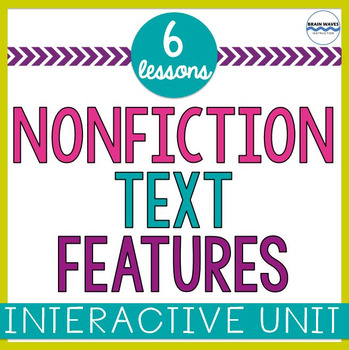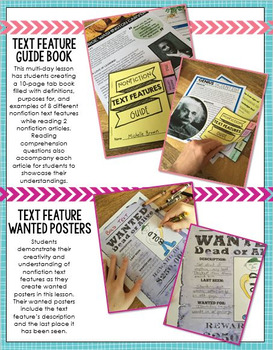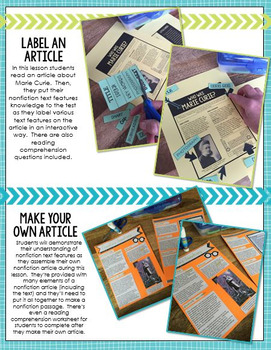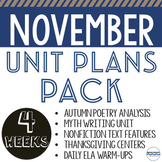Nonfiction Text Features: 6 Lessons & Activities for Reading Informational Texts
- PDF
What educators are saying
Also included in
- Help students learn critical skills in reading, writing, listening, and speaking this November with this bundle of resources. This bundle includes five resources that perfectly pair together, celebrate the time of year, AND help students learn a ton of skills in just 20 days! The best part? It’s aPrice $32.99Original Price $37.95Save $4.96
Description
This fun resource includes six engaging lessons about Nonfiction Text Features. Each lesson and activity is designed to be hands-on and interactive. Many of the elements that students create in the lessons can serve as a reference for them to use throughout the entire school year (match-up, search and find, guide book). The lessons about informational text features are designed so that they can be taught in succession or as separate activities throughout the entire school year. Four nonfiction passages about famous scientists are also included in this resource for cross-curricular integration. Reading comprehension questions accompany each nonfiction article as well. This unit is not only fun, it’s also jam-packed with ways for students to master Nonfiction Text Features.
Also, this unit aligns perfectly with these 5 Nonfiction Text Structure Doodle and Do units!
With these lessons, students will…
- Identify and understand nonfiction text features
- Cite textual evidence to support analysis of informational texts
- Determine the meaning of words and phrases in the text
- Summarize the text
- Develop skills for reading informational texts so that they can comprehend increasingly complex texts
- Write in response to their reading to showcase their reading comprehension
Nonfiction Text Features Lesson Overview:
- Nonfiction Text Features MATCH-UP: In this hands-on lesson students take a set of 12 mismatched nonfiction text features and sort them into perfect matches. In doing so, they’ll create a nonfiction text features Reference Guide that includes names, definitions, and examples of each text feature.
- Nonfiction Text Features SEARCH & FIND: Students go on a scavenger hunt in nonfiction books and magazines to find 12 nonfiction text features. Then, they compile their findings into a set of flip cards that they can string together.
- Nonfiction Text Features GUIDE BOOK: This multi-day lesson has students creating a 10-page tab book filled with definitions, purposes for, and examples of 8 different nonfiction text features while reading 2 nonfiction articles about Albert Einstein and George Washington Carver. Reading comprehension questions also accompany each article for students to showcase their understandings.
- Nonfiction Text Features WANTED POSTERS: Students demonstrate their creativity and understanding of nonfiction text features as they create wanted posters in this lesson. Their wanted posters include the text feature’s description, the last place it has been seen and what it is wanted for.
- LABEL AN ARTICLE with Nonfiction Text Features: In this lesson students read an article about Marie Curie. Then, they put their nonfiction text features knowledge to the test as they label various text features on the article in an interactive way. There are also reading comprehension questions included.
- MAKE YOUR OWN ARTICLE with nonfiction text features: Students will demonstrate their understanding of nonfiction text features as they assemble their own nonfiction article during this lesson. They’re provided with many elements of a nonfiction article (including the text) and they’ll need to put it all together to make a nonfiction passage. There’s even a reading comprehension worksheet for students to complete after they make their own article about Benjamin Franklin.
This detailed NONFICTION TEXT FEATURES unit includes:
• About the Resource & Lesson Overview
• Detailed Lesson Plans (6 total)
• Nonfiction Text Features Match-Up – Mismatched Cards (12)
• Nonfiction Text Features Reference Guide Sheet
• Nonfiction Text Features Match-Up – Answer Key
• Search and Find – Flip Cards – Cover pages and section dividers
• Search and Find – Flip Cards (12)
• Search and Find – Flip Cards and section dividers – Answers Key
• Guide Book – 10 pages with guided notes and text feature notes, purposes & examples
• Guide Book – Answer keys
• Nonfiction Articles (to accompany the guide book)
----- “Genius Scientist” – Alfred Einstein (color and black and white version)
----- Reading Comprehension Questions for “Genius Scientist”
----- “George Washington Carver” (color and black and white version)
----- Reading Comprehension Questions for “George Washington Carver
----- Answer Keys
• Nonfiction Text Features Wanted Poster (color and black and white version)
• Nonfiction Text Features Type Cards
• Wanted Poster Example
• Identify Nonfiction Text Features Types
• Cut-out arrows
• Nonfiction Article – “Who was Marie Curie?”
• Reading Comprehension Questions for “Who was Marie Curie?”
• Labeled article key
• Make Your Own Nonfiction Article Materials
----- Article text on Benjamin Franklin
----- Nonfiction text feature elements
----- Design elements
• Reading Comprehension Questions for Benjamin Franklin text
• Make Your Own Nonfiction Article Sample
• Reading comprehension answer keys
You may also like…
Following is Fun!
Get the inside scoop on all store discounts, free products, and product launches. Just click the green “Follow Me” star under my store name on this page or click the green “Follow Me” star on my store homepage.
Let’s Stay in Touch!
*** Click HERE to receive the Brain Waves Instruction Newsletter filled with exclusive FREEBIES and Teaching Tips!
Thanks!
Brain Waves Instruction






